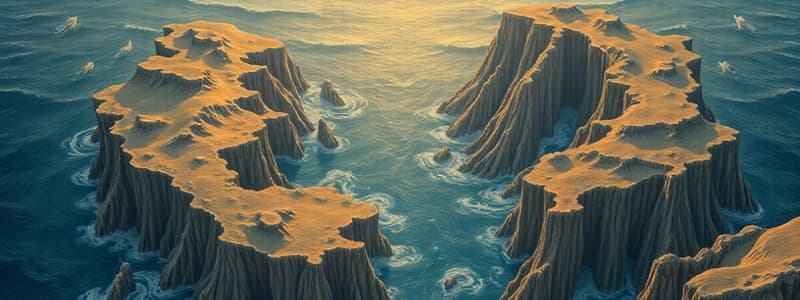Podcast
Questions and Answers
Which of the following is NOT a characteristic of an embryonic basin?
Which of the following is NOT a characteristic of an embryonic basin?
- Subduction associated with marginal trenches (correct)
- Crustal extension and uplift
- Igneous activity associated with thinning of the lithosphere
- Rift valleys and normal faults
What is the main difference between a juvenile basin and a mature basin?
What is the main difference between a juvenile basin and a mature basin?
- Mature basins have subduction, juvenile basins do not. (correct)
- Mature basins have active mid-ocean ridges, juvenile basins do not.
- Juvenile basins have high heat flow, mature basins do not.
- Juvenile basins have subduction, mature basins do not.
Which stage of the Wilson Cycle is characterized by the formation of palaeomagnetic stripes?
Which stage of the Wilson Cycle is characterized by the formation of palaeomagnetic stripes?
- Declining Basin
- Juvenile Basin
- Embryonic Basin
- Mature Basin (correct)
What is the term used to describe the gradual elimination of an ocean basin?
What is the term used to describe the gradual elimination of an ocean basin?
Which of these options is NOT a feature of a declining basin?
Which of these options is NOT a feature of a declining basin?
What geological process is mainly responsible for the fast rates of spreading at the East Pacific Rise?
What geological process is mainly responsible for the fast rates of spreading at the East Pacific Rise?
Which ocean basin is noted for its considerable mountain building and earthquake activity along its boundaries?
Which ocean basin is noted for its considerable mountain building and earthquake activity along its boundaries?
What characteristic best describes the Southern Ocean?
What characteristic best describes the Southern Ocean?
Which of the following accurately describes the Arctic Ocean Basin?
Which of the following accurately describes the Arctic Ocean Basin?
Which river system contributes to the large freshwater input in the Atlantic Ocean Basin?
Which river system contributes to the large freshwater input in the Atlantic Ocean Basin?
Flashcards
Wilson Cycle
Wilson Cycle
A sequence of events leading to the formation, growth, destruction, and elimination of ocean basins.
Embryonic Basin
Embryonic Basin
The initial stage of the Wilson Cycle characterized by continental rifting and crustal extension.
Juvenile Basin
Juvenile Basin
The stage following embryonic, marked by subsidence and ocean crust formation without subduction.
Mature Basin
Mature Basin
Signup and view all the flashcards
Declining Basin
Declining Basin
Signup and view all the flashcards
East Pacific Rise
East Pacific Rise
Signup and view all the flashcards
Terminal Basin
Terminal Basin
Signup and view all the flashcards
Suturing (Orogeny)
Suturing (Orogeny)
Signup and view all the flashcards
Pacific Ocean Basin
Pacific Ocean Basin
Signup and view all the flashcards
Arctic Ocean Basin
Arctic Ocean Basin
Signup and view all the flashcards
Study Notes
Wilson Cycle
- The Wilson Cycle describes the sequence of events leading to the formation, growth/expansion, destruction/contracting, and eventual elimination of ocean basins.
- The cycle involves stages: embryonic, juvenile, mature, declining, and terminal.
- Each stage has specific characteristics, including uplift, spreading, divergence, convergence, and subduction.
- Modern examples of each stage include East Africa rift valleys (embryonic), the Red Sea (juvenile), the Atlantic and Arctic Oceans (mature), the Pacific Ocean (declining), and the Mediterranean Sea (terminal).
Ocean Basins
- There is one world ocean, but it is divided into five major ocean basins: Pacific, Atlantic, Indian, Southern (Antarctic), and Arctic.
- The Pacific Ocean is the largest and deepest, covering 180,000,000 km².
- The Atlantic Ocean is the second-largest, covering 107,000,000 km². Its average depth is 3,310 m.
- The Indian Ocean covers 74,000,000 km², with an average depth of 3,840 m.
- The Southern Ocean, (Antarctic Ocean), covers 20,327,000 km², its average depth is 3,270 m.
- The Arctic Ocean, the smallest, covers 14,056,000 km² and its average depth is 1,038 m.
- Each basin exhibits unique characteristics, such as areal coverage, average depth, sediment input, marginal seas, and the presence of volcanic island systems and trenches.
Studying That Suits You
Use AI to generate personalized quizzes and flashcards to suit your learning preferences.




